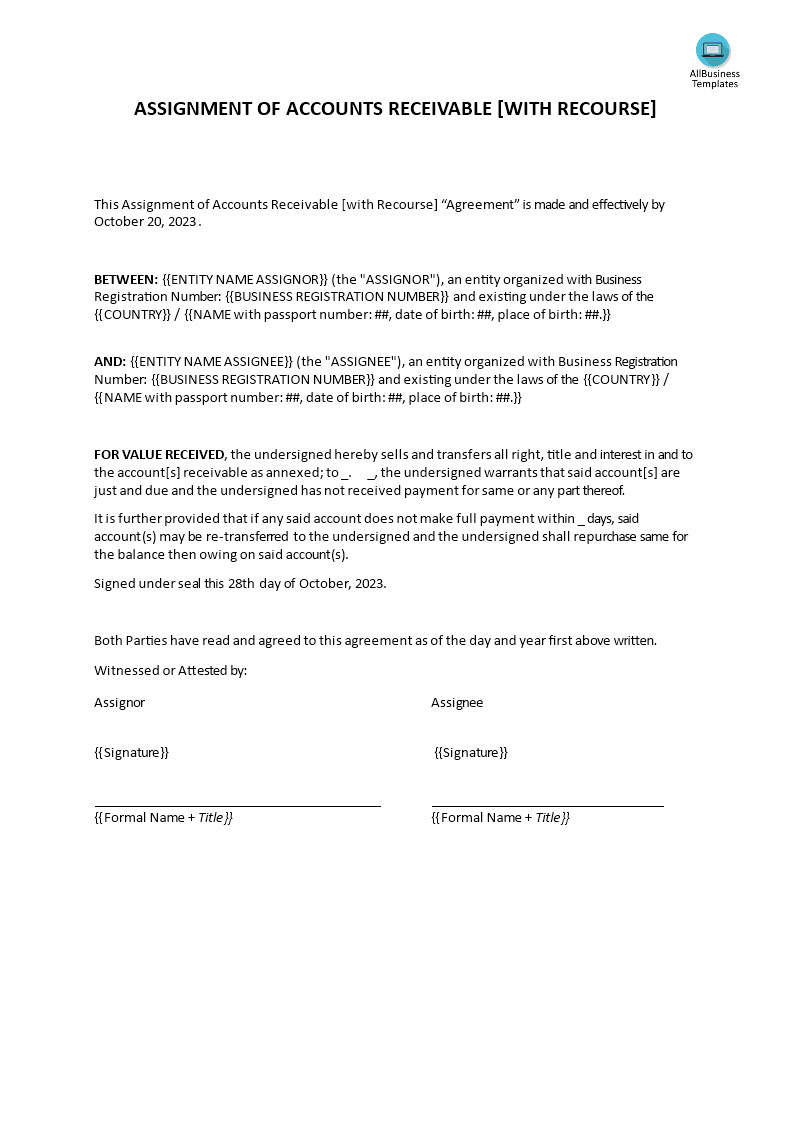Assignment Of Accounts Receivable [With Recourse]
Save, fill-In The Blanks, Print, Done!
![Assignment Of Accounts Receivable [With Recourse] main image Assignment Of Accounts Receivable [With Recourse] main image](/thumbs/6e04299e-3802-409d-b9f6-10da4f988dbc_1.png)
Download Assignment Of Accounts Receivable [With Recourse]
Today: USD 1.99
Download It Now

Available premium file formats:
Microsoft Word (.docx)- This Document Has Been Certified by a Professional
- 100% customizable
- This is a digital download (24.71 kB)
- Language: English
- You will receive a link to download the file as soon as your payment goes through.
- We recommend downloading this file onto your computer.
Do you need a Sample assignment of Accounts Receivable with Recourse? How is the assignment of receivables reported in the journal? Our template has everything you need to get started. It includes detailed instructions, sample language, and a sample form. With it, you can easily assign accounts receivable to the right person. Download this professional Assignment Of Accounts Receivable [With Recourse] template now!
An "Assignment of Accounts Receivable with Recourse" is a financial arrangement in which a business (the assignor) transfers or assigns its accounts receivable to a third party, often a financial institution or a factoring company (the assignee), while retaining certain responsibilities and risks associated with those receivables. This type of assignment is referred to as "with recourse" because the assignor remains liable for the collection of the assigned receivables if the debtor fails to pay them.
Here's how an Assignment of Accounts Receivable with Recourse typically works:
- Transfer of Receivables: The business (assignor) sells or transfers its accounts receivable to the third-party entity (assignee). This transfer typically involves a purchase agreement that outlines the terms and conditions of the assignment.
- Retained Liability: In a "with recourse" arrangement, the assignor retains liability for the receivables. This means that if the debtor (the customer who owes money) fails to pay the assigned receivables, the assignor is responsible for repurchasing them from the assignee.
- Funding: The assignee provides immediate funds to the assignor based on the face value of the assigned receivables, minus a discount or fee. This allows the assignor to access cash flow quickly without waiting for customers to pay their invoices.
- Collection and Administration: The assignee takes over the responsibility for collecting payments from the debtors. They may handle billing, collections, and follow-ups with customers.
- Recourse Period: The purchase agreement specifies a recourse period during which the assignor is obligated to repurchase any delinquent receivables. This period could be defined by a certain number of days or based on other criteria, as agreed upon in the contract.
- Recourse Obligations: If a debtor fails to pay a receivable during the recourse period, the assignor must buy back that receivable from the assignee at an agreed-upon price, which may include the full face value plus interest or other fees.
- Risk Mitigation: The assignor may use this arrangement to mitigate credit risk and improve cash flow. If a customer defaults, they can repurchase the debt and pursue collections themselves.
Assignment of accounts receivable with recourse is often used by businesses, especially those in industries with longer payment cycles, as a means to obtain working capital, manage cash flow, and transfer some collection responsibilities while retaining control and responsibility for the ultimate payment of the receivables.
We support you by providing this Assignment Of Accounts Receivable [With Recourse] template and you will see you will save time and increase your effectiveness. This comes with the benefit you will be inspired and motivated to finish the job.
Download this professional Assignment Of Accounts Receivable [With Recourse] template now!
DISCLAIMER
Nothing on this site shall be considered legal advice and no attorney-client relationship is established.
Leave a Reply. If you have any questions or remarks, feel free to post them below.
Related templates
Latest templates
Latest topics
- House Cleaning Schedule Daily Weekly Monthly
Cleanliness is not just about what’s outside; it reflects what’s inside." Check out our House Cleaning Schedule Daily Weekly Monthly templates here. - Google Docs Templates
How to create documents in Google Docs? We provide Google Docs compatible template and these are the reasons why it's useful to work with Google Docs... - Excel Templates
Where do I find templates for Excel? How do I create a template in Excel? Check these editable and printable Excel Templates and download them directly! - GDPR Compliance Templates
What do you need to become GDPR compliant? Are you looking for useful GDPR document templates to make you compliant? All these compliance documents will be available to download instantly... - IT Security Standards Kit
What are IT Security Standards? Check out our collection of this newly updated IT Security Kit Standard templates, including policies, controls, processes, checklists, procedures and other documents.
cheese
